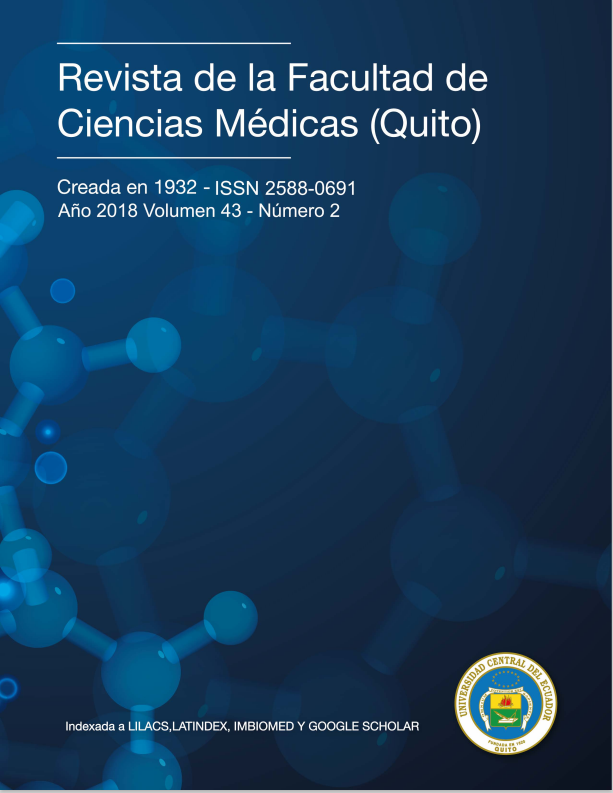The delay in the start time of classes significantly increases adolescent performance, a reflection for Public Health in Ecuador: a narrative review
DOI:
https://doi.org/10.29166/rfcmq.v43i2.2821Palabras clave:
privación del sueño, salud del adolescente, Ecuador, Salud Pública, desempeño académicoResumen
Contexto: en el Ecuador no existen estudios publicados sobre las horas de sueño por grupos de edad u horarios de inicio de clases enfocados al rendimiento académico de la población, en especial adolescentes. Discusión: al recopilar los datos de estudios realizados en niños y adolescentes, se demuestra que los adolescentes necesitan dormir lo suficiente para funcionar bien a diario y mejorar los efectos cognitivos que se presentan por la falta de sueño. Considerando solo el 14% al 27% de los adolescentes duermen más de 9 horas en las noches escolares, y peor aún, hasta el 25% duermen menos de 6 horas, no es sorprendente que la mayoría de los adolescentes se despierten sintiéndose cansados. Se recomienda planificar las horas de sueño con los padres, horario de tareas en casa y horarios de actividad física, para entrenar la mente y tener una buena higiene del sueño Conclusión: el retraso de la hora de inicio de clases aumenta notablemente el desempeño en los adolescentes, por lo cual se debe cambiar las p
Descargas
Métricas
Citas
Chaput JP, Dutil C, Sampasa-Kanyinga H. Sleeping hours: what is the ideal number and how does
age impact this?. Nat Sci Sleep. 2018;10:421–430. Published 2018 Nov 27. doi:10.2147/NSS.S163071
de Lima TR, Silva DAS. Association of sleep quality with sociodemographic factors and lifestyle
in adolescents from southern Brazil. World J Pediatr. 2018;14(4):383–391. doi:10.1007/s12519-018-
-8
Minges KE, Redeker NS. Delayed school start times and adolescent sleep: A systematic review of the
experimental evidence. Sleep Med Rev. 2016;28:86–95. doi:10.1016/j.smrv.2015.06.002.
Alsaggaf MA, Wali SO, Merdad RA, Merdad LA. Sleep quantity, quality, and insomnia symptoms of
medical students during clinical years. Relationship with stress and academic performance. Saudi
Med J. 2016;37(2):173–182. doi:10.15537/smj.2016.2.14288
Wheaton AG, Chapman DP, Croft JB. School Start Times, Sleep, Behavioral, Health, and Academic
Outcomes: A Review of the Literature. J Sch Health. 2016;86(5):363–381. doi:10.1111/josh.12388
Chaput JP, Dutil C, Sampasa-Kanyinga H. Sleeping hours: what is the ideal number and how does
age impact this?. Nat Sci Sleep. 2018;10:421–430. Published 2018 Nov 27. doi:10.2147/NSS.S163071
Instituto Nacional de Estadísticas y Censos. Compendio de Resultados - Encuesta Condiciones de
Vida ECV- Sexta Ronda, 2015. Disponible en: http://www.ecuadorencifras.gob.ec/documentos/webinec/ECV/ECV_2015/documentos/ECV%20COMPENDIO%20LIBRO.pdf
Krueger JM, Nguyen JT, Dykstra-Aiello CJ, Taishi P. Local sleep. Sleep Med Rev. 2019;43:14–21.
doi:10.1016/j.smrv.2018.10.001
Hirshkowitz M, Whiton K, Albert SM, et al. National Sleep Foundation’s sleep time duration recommendations: methodology and results summary. Sleep Health. 2015;1(1):40–43. doi:10.1016/j.
sleh.2014.12.010
Tremblay MS, Carson V, Chaput JP, et al. Canadian 24-Hour Movement Guidelines for Children and
Youth: An Integration of Physical Activity, Sedentary Behaviour, and Sleep. Appl Physiol Nutr Metab.
;41(6 Suppl 3):S311–S327. doi:10.1139/apnm-2016-0151
Boyko Y, Jennum P, Toft P. Sleep quality and circadian rhythm disruption in the intensive care unit: a
review. Nat Sci Sleep. 2017;9:277–284. Published 2017 Nov 10. doi:10.2147/NSS.S151525
Owens J; Adolescent Sleep Working Group; Committee on Adolescence. Insufficient sleep in adolescents and young adults: an update on causes and consequences. Pediatrics. 2014;134(3):e921–e932.
doi:10.1542/peds.2014-1696
Wheaton AG, Chapman DP, Croft JB. School Start Times, Sleep, Behavioral, Health, and Academic
Outcomes: A Review of the Literature. J Sch Health. 2016;86(5):363–381. doi:10.1111/josh.12388.
Minges KE, Redeker NS. Delayed school start times and adolescent sleep: A systematic review of the
experimental evidence. Sleep Med Rev. 2016;28:86–95. doi:10.1016/j.smrv.2015.06.002.
Adolescent Sleep Working Group; Committee on Adolescence; Council on School Health. School
start times for adolescents. Pediatrics. 2014;134(3):642–649. doi:10.1542/peds.2014-1697.
Guerrero MD, Barnes JD, Chaput JP, Tremblay MS. Screen time and problem behaviors in children:
exploring the mediating role of sleep duration. Int J Behav Nutr Phys Act. 2019;16(1):105. Published
Nov 14. doi:10.1186/s12966-019-0862-x
Bartel KA, Gradisar M, Williamson P. Protective and risk factors for adolescent sleep: a meta-analytic
review. Sleep Med Rev. 2015;21:72–85. doi:10.1016/j.smrv.2014.08.002
Al-Hazzaa HM, Alhussain MH, Alhowikan AM, Obeid OA. Insufficient Sleep Duration And Its As sociation With Breakfast Intake, Overweight/Obesity, Socio-Demographics And Selected Lifestyle
Behaviors Among Saudi School Children. Nat Sci Sleep. 2019;11:253–263. Published 2019 Oct 25.
doi:10.2147/NSS.S225883
Irwin MR. Why sleep is important for health: a psychoneuroimmunology perspective. Annu Rev
Psychol. 2015;66:143–172. doi:10.1146/annurev-psych-010213-115205
Royal Philips (NYSE: PHG, AEX: PHIA) empresa líder en tecnología de la salud, enfocada en mejorar la salud de las personas. Disponible en: https://www.philips.com.ar/aw/about/news/archive/standard/news/press/2018/20180611-encuesta-latinoamericana-sobre-el-sueno.html
Abrams RM. Sleep Deprivation. Obstet Gynecol Clin North Am. 2015;42(3):493–506. doi:10.1016/j.
ogc.2015.05.013.
McEwen BS, Karatsoreos IN. Sleep Deprivation and Circadian Disruption: Stress, Allostasis, and
Allostatic Load. Sleep Med Clin. 2015;10(1):1–10. doi:10.1016/j.jsmc.2014.11.007
McHill, A. W., Hull, J. T., Wang, W., Czeisler, C. A., & Klerman, E. B. (2018). Chronic sleep curtailment, even without extended (>16-h) wakefulness, degrades human vigilance performance. Proceedings of the National Academy of Sciences, 115(23), 6070–6075. doi:10.1073/pnas.1706694115 .
Tobaldini E, Costantino G, Solbiati M, et al. Sleep, sleep deprivation, autonomic nervous system
and cardiovascular diseases. Neurosci Biobehav Rev. 2017;74(Pt B):321–329. doi:10.1016/j.neubiorev.2016.07.004
Maric A, Montvai E, Werth E, et al. Insufficient sleep: Enhanced risk-seeking relates to low local sleep
intensity. Ann Neurol. 2017;82(3):409–418. doi:10.1002/ana.25023
Taveras EM, Rifas-Shiman SL, Bub KL, Gillman MW, Oken E. Prospective Study of Insufficient Sleep
and Neurobehavioral Functioning Among School-Age Children. Acad Pediatr. 2017;17(6):625–632.
doi:10.1016/j.acap.2017.02.001
Tremblay MS, Chaput JP, Adamo KB, et al. Canadian 24-Hour Movement Guidelines for the Early
Years (0-4 years): An Integration of Physical Activity, Sedentary Behaviour, and Sleep. BMC Public
Health. 2017;17(Suppl 5):874. Published 2017 Nov 20. doi:10.1186/s12889-017-4859-6
Taveras EM, Rifas-Shiman SL, Bub KL, Gillman MW, Oken E. Prospective Study of Insufficient Sleep
and Neurobehavioral Functioning Among School-Age Children. Acad Pediatr. 2017;17(6):625–632.
doi:10.1016/j.acap.2017.02.001
Moreira GA, Pradella-Hallinan M. Sleepiness in Children: An Update. Sleep Med Clin. 2017;12(3):407–
doi:10.1016/j.jsmc.2017.03.013
Touitou Y, Touitou D, Reinberg A. Disruption of adolescents’ circadian clock: The vicious circle of
media use, exposure to light at night, sleep loss and risk behaviors. J Physiol Paris. 2016;110(4 Pt
B):467–479. doi:10.1016/j.jphysparis.2017.05.001.
Badin E, Haddad C, Shatkin JP. Insomnia: the Sleeping Giant of Pediatric Public Health. Curr Psychiatry Rep. 2016;18(5):47. doi:10.1007/s11920-016-0687-0
Bathory E, Tomopoulos S. Sleep Regulation, Physiology and Development, Sleep Duration and Patterns, and Sleep Hygiene in Infants, Toddlers, and Preschool-Age Children. Curr Probl Pediatr Adolesc Health Care. 2017;47(2):29–42. doi:10.1016/j.cppeds.2016.12.001
Knufinke M, Nieuwenhuys A, Geurts SAE, Coenen AML, Kompier MAJ. Self-reported sleep quantity, quality and sleep hygiene in elite athletes. J Sleep Res. 2018;27(1):78–85. doi:10.1111/jsr.12509
Killgore WD. Effects of sleep deprivation on cognition. Prog Brain Res. 2010;185:105–129. doi:10.1016/
B978-0-444-53702-7.00007-5
Morgenthaler TI, Hashmi S, Croft JB, Dort L, Heald JL, Mullington J. High School Start Times and
the Impact on High School Students: What We Know, and What We Hope to Learn. J Clin Sleep Med.
;12(12):1681–1689. Published 2016 Dec 15. doi:10.5664/jcsm.6358.
Touitou Y, Reinberg A, Touitou D. Association between light at night, melatonin secretion, sleep deprivation, and the internal clock: Health impacts and mechanisms of circadian disruption. Life Sci.
;173:94–106. doi:10.1016/j.lfs.2017.02.008
Badin E, Haddad C, Shatkin JP. Insomnia: the Sleeping Giant of Pediatric Public Health. Curr Psychiatry Rep. 2016;18(5):47. doi:10.1007/s11920-016-0687-0
Bartel KA, Gradisar M, Williamson P. Protective and risk factors for adolescent sleep: a meta-analytic
review. Sleep Med Rev. 2015;21:72–85. doi:10.1016/j.smrv.2014.08.002
Irwin MR. Why sleep is important for health: a psychoneuroimmunology perspective. Annu RevPsychol. 2015;66:143–172. doi:10.1146/annurev-psych-010213-115205
Fatima Y, Doi SA, Mamun AA. Sleep quality and obesity in young subjects: a meta-analysis. Obes
Rev. 2016;17(11):1154–1166. doi:10.1111/obr.12444
Dutil C, Chaput JP. Inadequate sleep as a contributor to type 2 diabetes in children and adolescents.
Nutr Diabetes. 2017;7(5):e266. Published 2017 May 8. doi:10.1038/nutd.2017.19
Kim J, Hakim F, Kheirandish-Gozal L, Gozal D. Inflammatory pathways in children with insufficient
or disordered sleep. Respir Physiol Neurobiol. 2011;178(3):465–474. doi:10.1016/j.resp.2011.04.024
Shekari Soleimanloo S, White MJ, Garcia-Hansen V, Smith SS. The effects of sleep loss on young
drivers’ performance: A systematic review. PLoS One. 2017;12(8):e0184002. Published 2017 Aug 31.
doi:10.1371/journal.pone.0184002
Urry E, Landolt HP. Adenosine, caffeine, and performance: from cognitive neuroscience of sleep to
sleep pharmacogenetics. Curr Top Behav Neurosci. 2015;25:331–366. doi:10.1007/7854_2014_274
Jamieson D, Broadhouse KM, Lagopoulos J, Hermens DF. Investigating the links between adolescent
sleep deprivation, fronto-limbic connectivity and the Onset of Mental Disorders: a review of the
literature [published online ahead of print, 2019 Aug 29]. Sleep Med. 2019;66:61–67. doi:10.1016/j.
sleep.2019.08.013
Almojali AI, Almalki SA, Alothman AS, Masuadi EM, Alaqeel MK. The prevalence and association
of stress with sleep quality among medical students. J Epidemiol Glob Health. 2017;7(3):169–174.
doi:10.1016/j.jegh.2017.04.005
Kopasz M, Loessl B, Hornyak M, et al. Sleep and memory in healthy children and adolescents - a
critical review. Sleep Med Rev. 2010;14(3):167–177. doi:10.1016/j.smrv.2009.10.006
Noland H, Price JH, Dake J, Telljohann SK. Adolescents’ sleep behaviors and perceptions of sleep. J
Sch Health. 2009;79(5):224–230. doi:10.1111/j.1746-1561.2009.00402.x
Bartel KA, Gradisar M, Williamson P. Protective and risk factors for adolescent sleep: a meta-analytic
review. Sleep Med Rev. 2015;21:72–85. doi:10.1016/j.smrv.2014.08.002
Descargas
Publicado
Cómo citar
Número
Sección
Licencia
Derechos de autor 2018 Fabricio Gonzalez-Andrade, Carolina Ocaña-Terán, Gabriela Aguinaga-Romero

Esta obra está bajo una licencia internacional Creative Commons Atribución-NoComercial-SinDerivadas 4.0.










